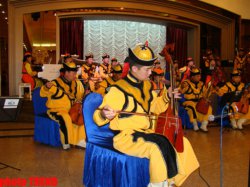 On the way to Kobdo, on the mountain where the Tuvan Arats Rebellion against the Manchu-Chinese invaders took place, starting from July, 8-10 the International Festival of Mongolian throat singing was held. We were invited to the ceremony. The Culture Minister of Tuva Vyacheslav Dongak led the delegation, comprised of the Dyngylday ensemble, the members of Khoomei center, and the National Orchestra of the Republic of Tuva. Descendants of Kobdo battle participants (already being elderly people), writers, and a group from Kyzyl City Hall were on a visit to Mongolian people apart from us.
On the way to Kobdo, on the mountain where the Tuvan Arats Rebellion against the Manchu-Chinese invaders took place, starting from July, 8-10 the International Festival of Mongolian throat singing was held. We were invited to the ceremony. The Culture Minister of Tuva Vyacheslav Dongak led the delegation, comprised of the Dyngylday ensemble, the members of Khoomei center, and the National Orchestra of the Republic of Tuva. Descendants of Kobdo battle participants (already being elderly people), writers, and a group from Kyzyl City Hall were on a visit to Mongolian people apart from us.
Officially, I was invited as a khoomei expert. Many professors and academicians gathered at the event, and it was a great pleasure to get on well with all of them and to find a common language. Ingenious throat singing performers being the guardians of music treasures and poetry of the peoples of Mongolia used to be highly respected persons among all the social stratums and the communities of Kobdo. The Festival was beautiful, in the wild nature, and you could see that it took a long while for them to prepare for the event. There were many dancers, singers, and children. Professional music directors and producers were managing the performances. Actually, Mongolians are very melodious and beautiful people with quite a few opera singers, and it pleases that there is a great number of young baritones.
As for the throat singing, there haven’t been done any broad comparative science researches, so a lot remains unclear. In general, Mongolian khoomei doesn’t belong to solo two-part texture and is very different from the Tuvan throat singing in its technical features. However, resembling elements occasionally appear in the middle or in the end of performances of Kobdo Tuvans.
Anyways, such performance represents a local tradition, specific only for the peoples of Mongolia, for whom it is a secondary consideration. I cannot say, if natural environment was contributing to khoomei development in Mongolia, as in Tuva. Mongolian khoomei sounds amazingly beautiful when an elder performer sings. It is separate and absolutely incomparable art.
 I reckon, a rhythmic recitation is primary in Mongolian khoomei. Such technique (through teeth, whistling) has never been noticed in Tuva. It seems like Mongolian khoomei follows a tradition to accompany instrumentally the performed epics.
I reckon, a rhythmic recitation is primary in Mongolian khoomei. Such technique (through teeth, whistling) has never been noticed in Tuva. It seems like Mongolian khoomei follows a tradition to accompany instrumentally the performed epics.
It was challenging to determine aurally the structure of the khoomei, since it was constantly accompanied by … phonogram unlike Tuvan. There was a case, when I asked the performers to sing in throat manner without a morin khuur, and they’ve just been lost. Mongolians cannot imagine singing without instruments. It’s interesting that, according to the available information, Mongolian throat singers did use the throat singing techniques when performing epics not so long time ago.
It should be noted that Tuvan artists, for instance, well known Aldyn-ool Sevek or Fedor Tau, never performed kargyraa technique with instrumental accompaniment. It tells us about natural geographical environment, in which solo two-part texture appeared, the mountain-steppe terrain. Presuming that the Tuvan’s habitat has been changing over time, it should be agreed on the opinion that the center of Turkic-Mongolian culture is apparently Tuva (Aksenov).
Anyway, Tuvan-Mongolian relations in the field of throat singing art are the reality and they require a specific study that includes a comparative research of the performing techniques in Tuva and Mongolia. Obviously, any culture does not exist on its own. It develops in cooperation and mutual enrichment with others.

